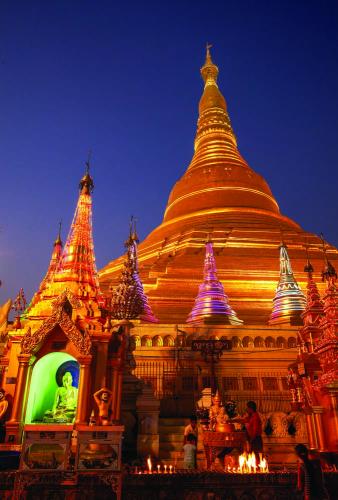
In the assessment of no less than Rudyard Kipling, the south Asian nation that—these days—is referred to as Myanmar has long been unique in the world: “Then golden mystery upheaved itself on the horizon, a beautiful winking wonder that blazed in the sun, of a shape that was neither Muslim dome nor Hindu temple-spirit. It stood upon a green knoll, and below it were lines of warehouses, sheds, and mills.”
Kipling wasn’t wrong. He was writing about the Shwedagon Pagoda in Yangon (or Rangoon, as it might be better known), in what was then called Burma. And the Shwedagon Pagoda and the country’s Irrawaddy River, which runs down that nation’s center, are, in some ways, the centers of the nation’s soul. And yet, now, after nearly twenty-five years of enforced silence—both imposed by the country’s own militaristic government and then by international sanction and financial isolation due to political and human-rights issues—the country has now decided to reenter the world.
While I’ve never been one to predict the future, I’d be surprised if the political changes and economic reopening of Myanmar (or, as it’s better known by its old colonial name, Burma) wasn’t soon to remake south Asia’s geopolitical landscape.
The Shwedagon spire is still there. It has sun-warmed marble flooring for several acres around it in a checkerboard kind of outline in three-foot squares. In the evenings, the air has birdsong and silence beneath the fading sky. The pagoda that sits at its center is a roughly 300-foot-tall gilded tower that, at last count, had at least fifty-three metric tons of pure gold slathered on it. Plus, there are dozens of pounds of diamonds and rubies and other precious gems adorning the Shwedagon tower’s peak. And encircling it are something on the order of fifty smaller temples and monoliths.
The story goes: the monument was built by two brothers to honor and enshrine a grand total of eight hairs given to them by the Buddha himself, when he was traveling. Still, as a symbol instead of a marker, it’s larger than that. But really, when Kipling wrote his words, he was also thinking bigger in terms of metaphor: he was talking about the whole country.
Aside from being the largest and most minerally rich nation in continental south Asia, Burma also ranks among the most beguiling and un-homogenized places on Earth. The people are roughly 100 tribes encircled by a national boundary put into place by the colonial British. So it’s no great wonder that their history, over time, has been a little broken-up by armed disagreement. And still, in their independence and cultural uniqueness, they are each wonderful.
Add to this that the country’s largely jungled and mountainous landscape, plus rivers and lakes that are both isolating for some tribes and also nothing short of flat-out, you’ll-never-catch-up-to-this-again beautiful. A lot of it sits at the feet of Himalayan foothills and many of their taller peaks, which wait beyond. In the following pages, you’ll see some of that. And this summer, finally, after nearly a quarter-century of self-imposed isolation, while Burma’s people—and military—have attempted to figure out its future after a difficult period that included everything from a run at socialism to the house arrest of its elected leader during a military coup, the country is finally reaching outside itself in the hopes of engaging the world. It’s a lovely thing to watch and experience, for both the people inside and those outside Burma’s borders. The planet and all its inhabitants will be richer for it.
This Summer 2012 issue of VQR contains features about Burma as it reopens to the world since shuttering itself in 1990. It also has several other stories and essays. We have Elliott D. Woods’s story on how, these days, even the headhunting tribes of northwest Burma are being modernized and acclimatized to a larger world. We have Jason Motlagh on a Joseph-Conrad-style barge trip down Burma’s central river to—once again—the place where possibly the nation’s soul resides, the Irrawaddy. We have Delphine Schrank on the dissident movement that—during a slow flood of proposed freedom—worked tirelessly from prison cells and outside the national boundaries to change a militaristic junta into something resembling a fledgling democracy. Adventurer and writer Robert Young Pelton, author of the acclaimed The World’s Most Dangerous Places, also tests his skills inside a forbidden “black zone” in southeast Burma. The region is home to the Karen tribe, who, until recently, were in a two-decade war with the Burmese Army, with the Karen being armed through legal sales of goods (and, perhaps, less legal sales of other goods like opium and amphetamines).
We have award-winning fiction authors Edith Pearlman and Madison Smartt Bell writing stories that couldn’t be more diverse (two brothers in Brooklyn in the former, and a Native American Creek chief about to go to war with Andrew Jackson in the latter). Not to mention Janna Malamud Smith on why the pursuit of art-making can sometimes require both gentle, and thoughtful, care measured with hard-minded ruthlessness.
Also inside is a memoir by the new President of Ghana, John Dramani Mahama, about his political coming of age. He writes about how—following his father being forced out of the national Parliament during a period of political and social uprising—he came to help his country return to a stable, democratic, and constitutional government.
Inside these covers, there’s some truly wonderful poetry, plus a Willard Spiegelman essay on the remarkable poet Kay Ryan, and a new batch of columns at the back of the magazine, to leave you thinking about what’s coming next time. We have Mark Jenkins—a regular in Outside and National Geographic magazines, and the author of several non-fiction books—writing thoughtfully on a family in an isolated area of Xinjang in northwest China. And also Chuck Leavell (who happens to be among America’s top tree-farmers and is also the keyboardist for everyone from The Allman Brothers Band and The Rolling Stones to Eric Clapton and John Mayer) on why you should know and respect and work to support the place where you live. His column is called “40 Acres and a Year.” Leavell will be a regular. Plus, there’s the renowned literary critic Michael Dirda—who we plan to have in these pages regularly—on the controversial and interesting book, The Lifespan of a Fact, by John D’Agata and Jim Fingal. Dirda does a great job with a book that merely explores the nature and truth of “reality.”
As a magazine, in my estimation, it’s a full meal. The world remains a very interesting place. And there’ll be more to cover in coming issues. And we’re going to get at all of it we can within this publication’s covers. Hope you enjoy the issue.







